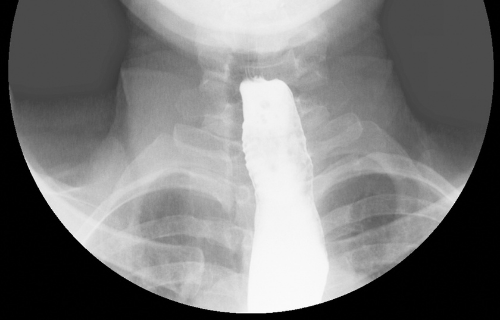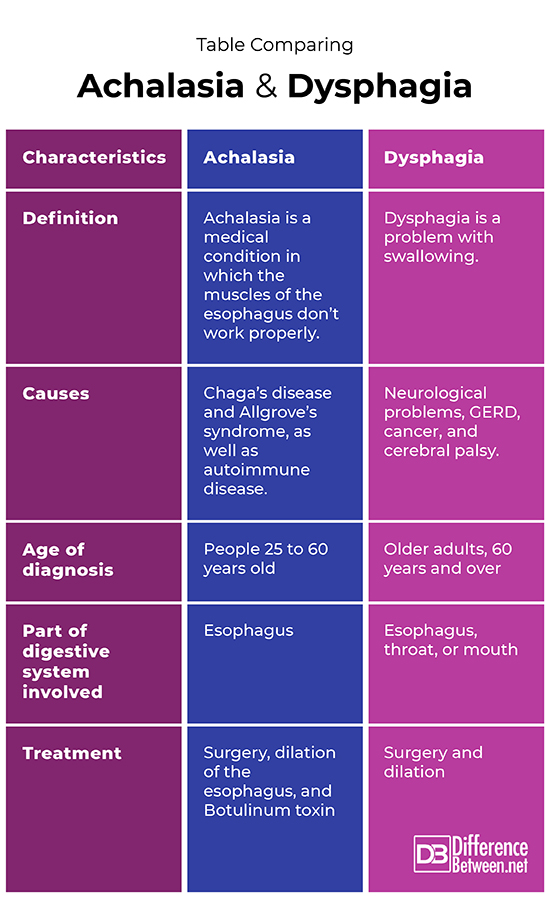Difference Between Achalasia and Dysphagia
Achalasia is a term used to describe a muscular problem that negatively affects the esophagus. Dysphagia is a term used to describe difficulty in being able to swallow.

What is Achalasia?
Definition:
Achalasia is a condition in which the muscle tissue of the esophagus, including the lower esophageal sphincter, does not work properly.
Causes and risk factors:
Achalasia occurs when there are problems with the muscle tissues in the esophagus, including the sphincters. Certain conditions like Allgrove’s syndrome or Chagas’s disease can cause achalasia. Risk factors for achalasia include having any of the conditions mentioned above. Cancerous tumors in the esophagus can also result in achalasia.
Diagnosis:
Viewing the esophagus and the esophageal sphincters using an endoscope can help with diagnosis as can an X-ray after the person swallows barium.
Symptoms and complications:
A person with achalasia finds it problematic to swallow both liquids and solid food items. Some further possible signs of achalasia include belching, chest pain, regurgitation, and chest pain. The condition can cause a complication called aspiration pneumonia, which can be dangerous and result in the person needing to be placed in the hospital.
Treatment:
The treatment options for achalasia can include using Botulinum toxin injections to help where muscle spasms occur. Balloon dilation to widen narrowed regions of the esophagus is another option for treating achalasia. Surgical excision of muscle tissue where there is a problem is a further method that is sometimes used to treat achalasia. Surgery also works for cancerous tumors of the esophagus.

What is Dysphagia?
Definition:
Dysphagia is a general term used when a person has a problem swallowing.
Causes and risk factors:
There are a number of potential causes of dysphagia including problems that are associated with the nervous system, for example, disorders like multiple sclerosis (MS) or Parkinson’s disease, in which nerve function is impaired and the person struggles to swallow as a result. Gastroesophageal reflux disease (GERD) is another cause of swallowing problems if it is untreated. Cerebral palsy and cancer are also causes of dysphagia. Risk factors include having a neurological problem, having GERD, cancer, or cerebral palsy. Achalasia is also a cause of dysphagia.
Diagnosis:
Diagnosis is based on a physical exam and noting the symptoms that the person has. Further diagnostic tests can include upper endoscopy and an X-ray done after swallowing barium. How well the person swallows can be detected by the barium swallow method.
Symptoms and complications:
Symptoms may include drooling saliva when the person swallows along with a feeling that they are choking or food is stuck. Regurgitation of food and cough are also symptoms of dysphagia. The main complication of dysphagia is aspiration pneumonia, where lungs become infected because of food or liquid particles entering into the lungs instead of the stomach.
Treatment:
The treatment method depends on what the cause of the dysphagia is. In the case of tumors, surgery can work to remove obstructions in the esophagus. Dilation of the esophagus may be needed where there is a narrowing (stricture). Enteral feeding may be needed for those who have a neurological disease that is causing dysphagia.
Difference between Achalasia and Dysphagia
Definition
Achalasia is when tissues like the esophageal sphincter and the muscles in the esophagus don’t work properly. Dysphagia is when a person cannot swallow properly.
Causes
Achalasia is due to a muscle problem, which is also related to nervous innervation in some cases. Cancer, Chaga’s disease, and Allgrove’s syndrome can result in achalasia. Dysphagia can be caused by achalasia, but also by neurological problems, GERD, cerebral palsy, or cancer.
Age of diagnosis
Achalasia is a problem that strikes people most often when they are somewhere in the age range of 25 to 60 years of age. Dysphagia is a condition that is most common in people older than 60.
Part of the digestive system involved
The part of the digestive system affected by achalasia is the esophagus while the part of the digestive system affected by dysphagia is the mouth, esophagus, or throat.
Treatment
Achalasia can be treated using Botulinum toxin, surgery, or balloon dilation. Dysphagia can be treated using dilation or surgery.
Table comparing Achalasia and Dysphagia

Summary of Achalasia and Dysphagia
- Dysphagia is a symptom of achalasia or some other condition causing problems with swallowing.
- Achalasia specifically refers to problems of swallowing related to muscle and sphincter problems in the esophagus.
- Both achalasia and dysphagia can have complications of aspiration pneumonia, which can be very dangerous.
FAQ
What are the three types of achalasia?
There is type I, type II, and type III achalasia. The type classification is based on how severe the problem is with type I being the least severe and type III being the most severe problem of the esophagus.
What are the 2 types of dysphagia?
The two types of dysphagia are called oropharyngeal or esophageal dysphagia. They are named for where the problem is, so in the case of oropharyngeal dysphagia, the difficulty is in the mouth and throat, while for esophageal dysphagia the issue is with the esophagus.
What is achalasia dysphagia?
This is achalasia in which there is a lot of difficulty in swallowing because of problems with the esophageal sphincter that occurs by the stomach.
- Difference Between Rumination and Regurgitation - June 13, 2024
- Difference Between Pyelectasis and Hydronephrosis - June 4, 2024
- Difference Between Cellulitis and Erysipelas - June 1, 2024
Search DifferenceBetween.net :
1 Comment
Leave a Response
References :
[0]Lynch, Kristie Lee. “Achalasia (Cardiospasm; Esophageal Aperistalsis; Megaesophagus)”. Merck Manual, 2021, https://www.msdmanuals.com/professional/gastrointestinal-disorders/esophageal-and-swallowing-disorders/achalasia
[1]Lynch, Kristie Lee. “Dysphagia”. Merck Manual, 2021, https://www.msdmanuals.com/professional/gastrointestinal-disorders/esophageal-and-swallowing-disorders/dysphagia
[2]Patel, Dhyanesh A., Brian M. Lappas, and Michael F. Vaezi. "An overview of achalasia and its subtypes." Gastroenterology & hepatology 13.7 (2017): 411.

Cute and educational